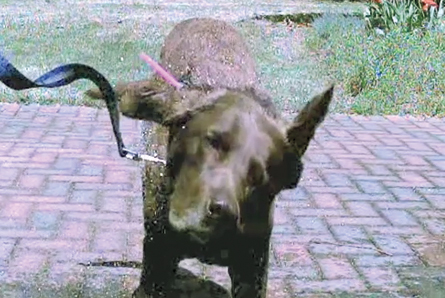- More than 2 years ago

What does a wet dog have in common with a salad spinner? Plenty, according to mechanical engineers at the Georgia Institute of Technology in Atlanta.
When animals shake to rid themselves of water, they do so in the most dynamically efficient manner, just as a salad spinner strips most droplets off the romaine.
“The animals are shaking at optimal frequencies,” says team member David Hu. “I think it’s pretty amazing they can do that.” His team’s paper appears on arXiv.org, as an entry in a fluid dynamics video contest run by the American Physical Society.
Hu’s lab studies animals that exploit surface tension, like water striders that walk across streams and ants that link together in rafts to keep from drowning. Led by graduate student Andrew Dickerson, the researchers videotaped 40 wet hairy mammals of 15 species shaking themselves dry, from mice to Chihuahuas to tigers. Mice and rats came from the university’s research labs; dogs from various team members and their friends; and the tiger and the panda from the local zoo. No animals were harmed in the university-approved drenching, Hu notes.
The researchers found that the bigger an animal gets, the slower it shakes. Whereas a mouse shakes off water with a frequency of 27 hertz, meaning it shakes back and forth 27 times a second, a grizzly bear does it at 4 hertz.
Loose skin also played a role in releasing fluid more efficiently. By sticking a fluorescent straw on the back of a dog and videotaping the animal shaking, the researchers saw how the skin can oscillate 90 degrees on either side of the spine — releasing more water than if the skin were tighter.
Knowing how animals shake themselves dry is more than just an intellectual puzzle. “If a dog couldn’t dry itself, we calculated that it would have to use 25 percent of its daily calories to heat its body to get rid of the water,” says Hu. “Every time they got wet they would get hypothermia and die.”
The researchers have also worked with Whirlpool to try to build a more efficient washing machine. But they haven’t gotten anywhere, because unlike dogs and other animals that are optimized to get rid of water as fast as possible, the big clot of clothes inside a washer drum makes efficient spinning nearly impossible, says Hu.
The team is now probing further into how hair and water droplets interact, studying aquatic animals like beavers and otters to see how they have adapted to life in the water.
QUICK-DRY from Science News on Vimeo.
When a furry animal shakes itself dry, it gyrates at a frequency that is optimized for its size. Mice and other small creatures shake fast; bigger beasts, such as bears, more slowly.
Credit: Andrew Dickerson, Grant Mills, Jay Bauman, Young-Hui Chang, David Hu





